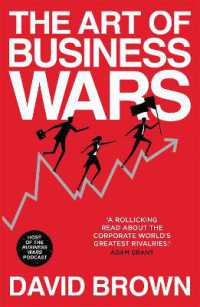- ホーム
- > 洋書
- > 英文書
- > History / World
Full Description
Every society has its lineup of wicked, unethical characters--real or fictional--who are regarded as villainous. This book explores how Western societies have used villains to sort insiders from outsiders and establish behavioral norms to support harmony and well-being. There are three parts: nature and "barbarians" as sinister "others" bent on destroying Western civilization; tyrants, traitors and "femmes fatales" as challenges to ideals of legitimate governance, patriotism and gender roles; and gangsters, grifters and murderers as models of evil or unprincipled behavior. The author also discusses two related phenomena: the dramatic paring down of what is considered villainous in the West, and the proliferation of over-the-top villains in pop culture and mass media.
Instructors considering this book for use in a course may request an examination copy here.
Contents
Table of Contents
Acknowledgments
Introduction
Part One. Drawing Lines in the Sand: The Villain as "Other"
1. "Red in tooth and claw": The Villain as Nature
2. Sybarites and Savages: The Villain as Barbarian
Part Two. Tyrants, Traitors and Tramps: The Villain as Agent of Discord and Disorder
3. "One who rules without law": The Villain as Tyrant
4. "Et tu, Brute?": The Villain as Traitor
5. "Her arms are wicked and her legs are long": The Villain as Femme Fatale
Part Three. The Bad Seed: The Villain as Pathology
6. Gangsters and Grifters: The Villain as Sociopath
7. Rippers and Rapists: The Villain as Psychopathic Murderer
Epilogue. Marplots and Madmen: The Villain as Metaphor
Chapter Notes
Bibliography
Index








